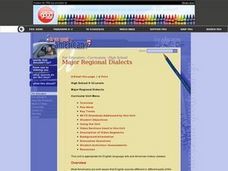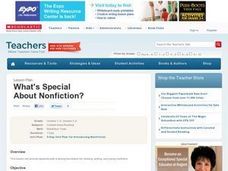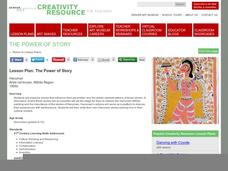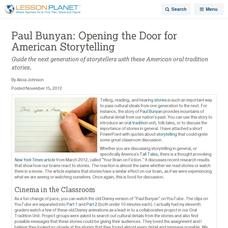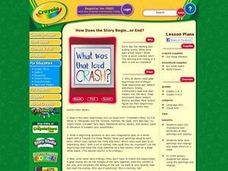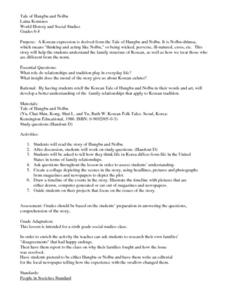Curated OER
Major Regional Dialects
What does your dialect sound like? Examine variation in English as it relates to geographic regions with your class. They recognize some of the major differences between regional dialects and determine that everyone speaks a dialect....
Curated OER
What's Special About Nonfiction?
Students examine the difference between nonfiction and fictional writing. They identify the characteristics of nonfiction literature and examine how a nonfiction textbook organizes information.
Curated OER
Telling Stories Through Dance
Examine the movement of characters in the story, Caps for Sale. Using the text, pupils invent gestures and movements for some of the actions and major events. They practice retelling a story by using the movements they developed. They...
Curated OER
Lesson: The Power of Story
Universal themes found throughout the world in the form of stories is the topic of today's activity. Upper graders analyze the cultural context of the Mithila piece, Hanuman. They consider the universal themes the image depicts and how...
Curated OER
Language and Dialect
Practice listening skills while studying oral story tellers from different parts of Louisiana. Consider the regional dialects and insider language of folk groups with your class. Identify language as part of folk life and recognize that...
Curated OER
Understanding Dialect as Used by Mark Twain
A reading of Mark Twain’s The Celebrated Jumping Frog of Calaveras County not only offers pupils an opportunity to practice their listening skills but also provides them with examples of dialectic speech. This is the gol’derndest lesson...
Curated OER
Ordering Stories
What happened first? Learners examine four sets of images to sequence events using ordinal numbers. There is an example to get them started, and the first two have three pictures to organize. The final story is more challenging with four...
Curated OER
Paul Bunyan: Opening the Door for American Storytelling
Guide the next generation of storytellers with these American oral tradition stories.
Curated OER
Visualization: Cricket in Times Square
After reading The Cricket in Times Square chapter titled "Caught in the Kitchen," learners list three describing details about the characters and setting. Groups collaborate to find sensory details to support their character assertions....
Curated OER
Alphabet Poems
Develop fluency with a variety of works. Help kindergartners use multiple strategies to understand text and decoding. They will create an alphabet poem book on Kid Works 2 to illustrate and write their own poem. In the end, they will...
Curated OER
The Harlem Renaissance Births a Black Culture
Students examine the men and women who were a part of the Harlem Renaissance. Individually, they recreate their favorite pieces of art from the time period and create their own original works after reading poem from the movement. In...
Curated OER
Language Dialects and the Film "Nell"
Students view the film "Nell" and analyze it for presentation of language pathologies and dialects. They consider the definition of dialect, research phonetic representation of dialects and observe their own communities for speech patterns.
Curated OER
Rhyme Brainstormers
Students identify words that rhyme and realize that this literacy skill is engaging. Then they prepare their own language game props. Students also monitor each other in following rules, erasing duplicate words, and scorekeeping....
Curated OER
How Does the Story begin...or End?
Students explore the importance of the opening and closing of a story. They assess that an exciting beginning gets readers attentions and strong introductions hook and lead readers into the book or story.Also, a good conclusion leaves...
Curated OER
Tell Me A Story -- Feelings
Practice using feelings as a way to reflect on past experiences. The poem The End and the text Tell Me a Story Mama are used to identify feeling words. As an extension, pupils participate in a service learning project and...
Curated OER
Making Sense of Our Senses
Students participate in activities about the five senses. They explore objects, listen to stories and discuss the senses with classmates.
Curated OER
Fables: A Short Anthology
Explore fables with your class. Learners read a series of fables, including The Mouse and the Lion, and then match the moral to the correct story. This is a great way to end a unit on fables. This resource could also be used to explain...
Curated OER
I Can Lick 30 Tigers Today! And Other Stories
Young scholars read a story by Dr. Seuss and create characters from the story. In this lesson about reading a story, students will read I Can Lick 30 Tigers Today! And Other Stories. Young scholars make a tiger tail with a felt strip,...
Curated OER
It's A Mystery To Me
Learners become both mystery readers and writers. They utilize the Internet to understand the elements of this classic genre; employ critical thinking skills when reading various stories in both print and electronic formats; form groups...
Curated OER
Lesson Plan for Korea: P'ansori
Twelfth graders read different versions of P'ansori in an attempt to gain exposure to this form of literature. They gain information in order to help understand the context of how they are part of the Korean culture.
Curated OER
Passport to Stories Around the World
Students read stories from various cultures and create a passport indicating the completion and comprehension of the story. The template for the passport is included. The instructional activity can be used for a broad range of ages...
Curated OER
Headline News
Students create stories using words cut from newspaper headlines. They put together words to create headlines and demonstrate creative thinking and creative writing skills.
Curated OER
Lesson Plan on the Mayflower, the Pilgrims and the Wampanoag
Fifth graders write journal entries and a story based on the Mayflower era. They identify the roles of both the Pilgrims and Wampanoags in their writings.
Curated OER
Tale of Hungbu and Nolbu
Engage in a lesson that is concerned with the teaching of family values for helping to understand Korean culture. The values of Koreans is explored using a literature study.


